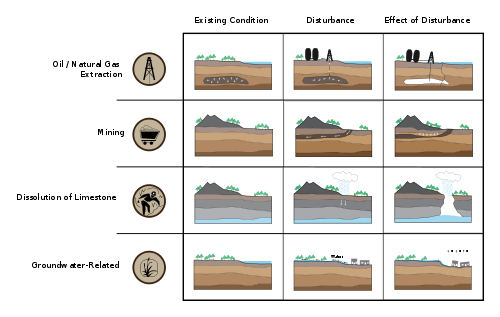Subsidence is a gradual or abrupt sinking of earth that may be caused by natural or man-made occurrence or cause. It can bring damage to roads and infrastructures, slopes and streams.
There are two kinds of subsidence: the endogenic and the exogenic. Endogenic subsidence happens when there is movement of tectonic plates and earthquakes. Meanwhile, Exogenic subsidence are usually caused by activities performed by humans such as natural gas extraction, ground water withdrawal, underground mining and changes in soil composition.

Endogenic Subsidence
Endogenic subsidence as explained is made by nature. When there are movements in tectonic plates, sinking of earth in some parts can be seen.
- Folding and Faulting
- This is mainly due to the shifting of tectonic plates but this occurrence can be gradual. Folds are bends in the rocks caused by compressional forces. Faults are cuts in the rocks formed due to huge or massive stress.
- Earthquake
- The subsidence made by an earthquake is very rapid in nature. Earthquake can bring about a process called liquefaction wherein quick vibrations or tremors produce water-saturated sediments to temporarily melt; hence the soil or material above the melted sediment also subsides.
Exogenic Subsidence
As briefly explained, exogenic subsidence is made by human activities in the likes of underground mining, fuel extraction and groundwater withdrawal.
- Mining
- Mining is a renowned technique or method used to bring out ores like metals and minerals from the ground. However, this activity can create voids in the earth and causes the upper ground to weaken or collapse eventually. The collapsed areas are commonly known as troughs or sinkholes.
- Groundwater Withdrawal
- This method is beneficial to men since we need fresh water to use in our daily activities. But this activity also means that we need to extract water from between the pore spaces in gravel, sand, clay and silt which results to reduction of water pressure. The area from where pumping and extraction was performed eventually weakens and is lowered.
